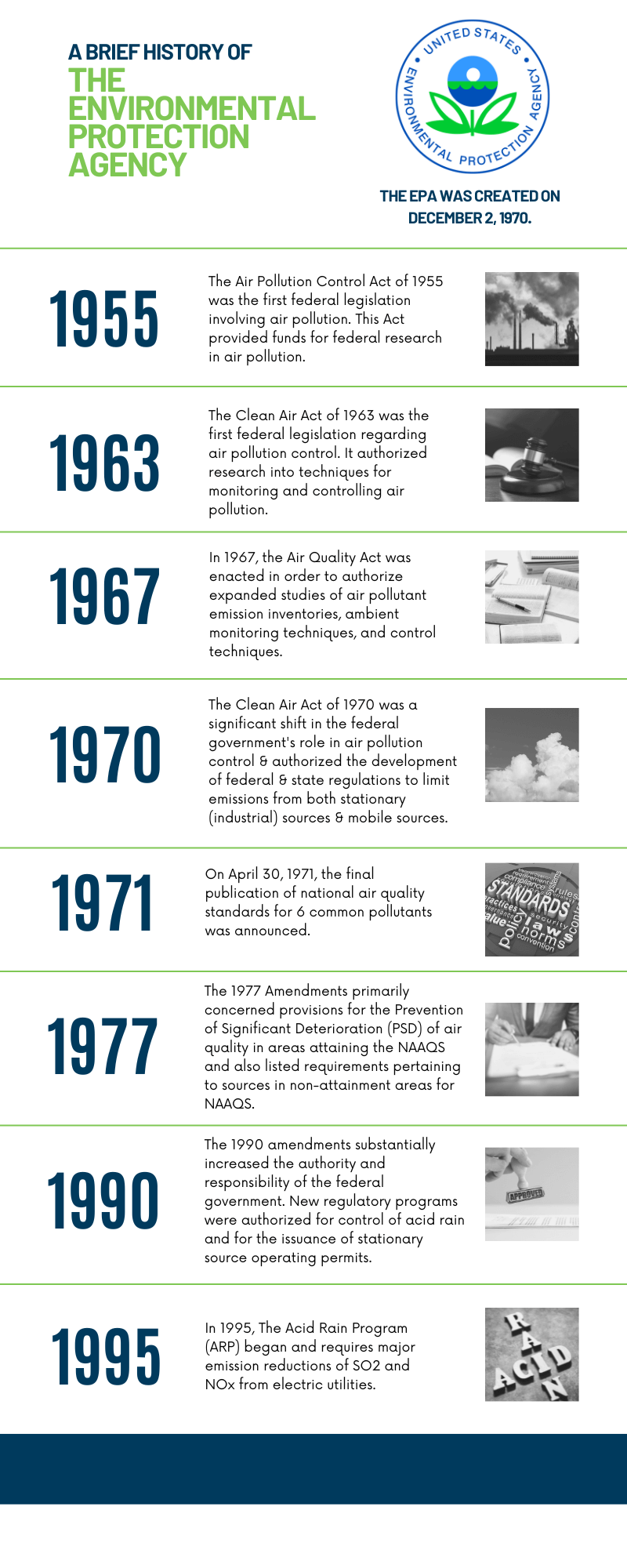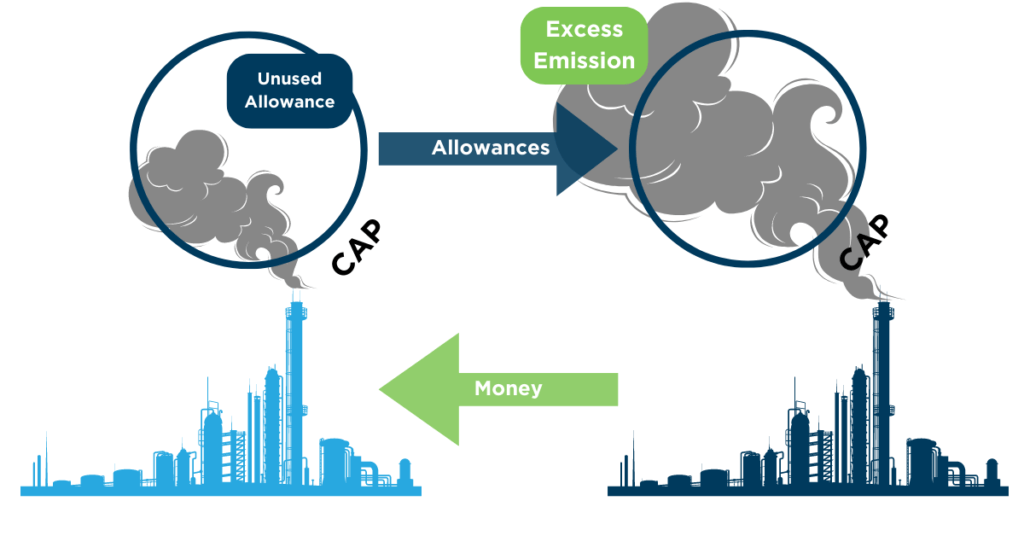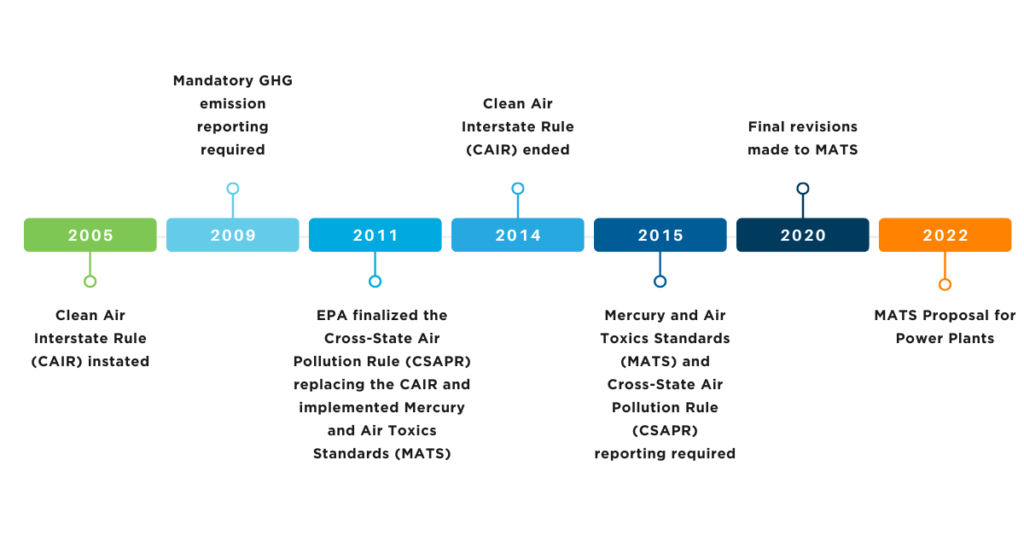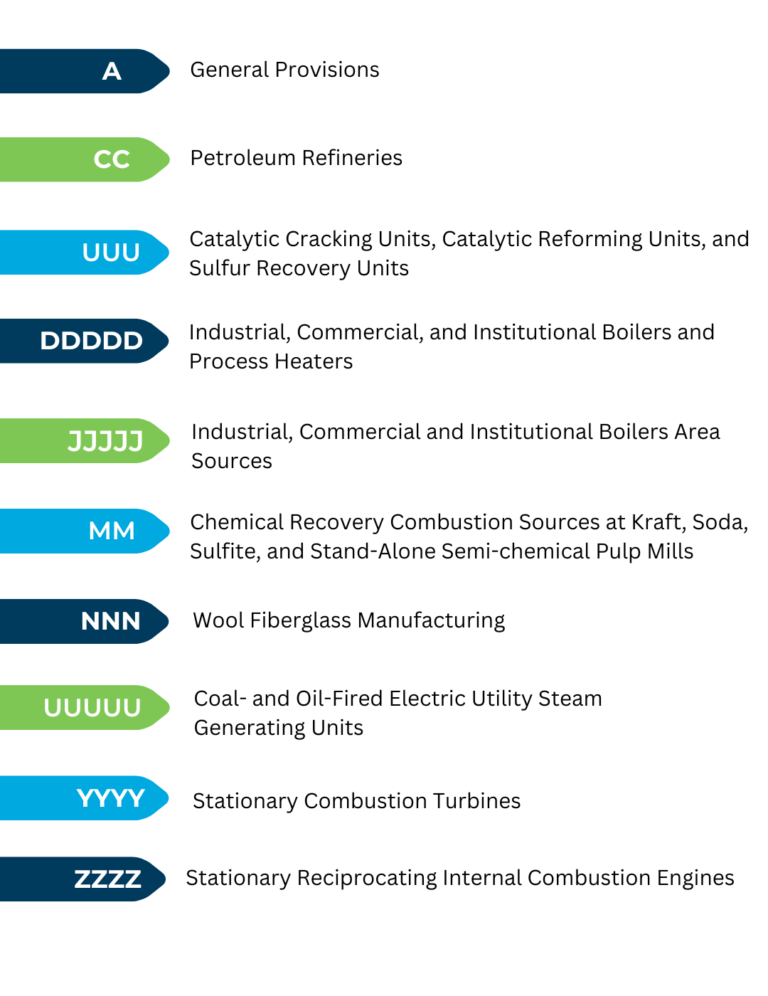The Definitive Guide to Air Emissions Regulations
If you want to learn about environmental compliance and the EPA regulations for air emissions at your facility, you’ve come to the right place.
Over the years, ESC Spectrum has published tons of educational materials on our Source Blog and YouTube Channel, helping thousands of people in the CEMS industry have a better understanding of what regulations their facility falls under and helping them comply.
We’ve created this guide just for you. Whether you’re new to the CEMS world or already know the basics of air emissions regulations, this page is your gateway to environmental compliance mastery.
Table of Contents
The Clean Air Act: A Landmark Passage
The Clean Air Act of 1963 was the first federal legislation regarding air pollution control. It established a federal program within the U.S. Public Health Service and authorized research into techniques for monitoring and controlling air pollution.
In 1967, the Air Quality Act Amendment was passed to broaden federal involvement in managing air quality. This led to enforcement actions in areas affected by interstate air pollution, including extensive monitoring studies and inspections of stationary sources. The 1967 Air Quality Act also allowed for increased research into emission inventories, monitoring methods, and pollution control techniques.
On December 31, 1970, President Richard Nixon signed the Clean Air Act Amendments. This legislation includes:
- National Ambient Air Quality Standards (NAAQS)
- Required State Implementation Plans (SIPs)
- Regulated Hazardous Air Pollutants (HAPs)
- New Source Performance Standards (NSPS)
Consequently, it caused a major change in the government’s air pollution control role, leading to rules for emissions from stationary and mobile sources.
Moreover, the Clean Air Act prioritized the reduction of outdoor ambient air pollutant concentrations responsible for issues like smog, haze, acid rain, and more. Additionally, it also aimed to reduce toxic air pollutants causing cancer and health issues while eliminating ozone-depleting chemicals, mainly from stationary sources like chemical and power plants.

Air Emissions Regulation Timeline
Let's Review the EPA's History
Historical coal-burning bans date to the 1300s. However, it wasn’t until the 1930s-1970s that US communities started to take steps to reduce smog:
- 1955 – The Federal Air Pollution Control Act was put in place
- 1963 – The Federal Clean Air Act was enacted, with a particular focus on cars
- 1967 – The Federal Air Quality Act was passed for stationary sources
- On December 2, 1970, the Environmental Protection Agency was created
Establishing National Air Quality Standards
On April 30, 1971, national air quality standards for six common pollutants were published. The National Ambient Air Quality Standards (NAAQS) define the maximum amount of a pollutant averaged over a specified period that can be present in outdoor air without harming public health. The Clean Air Act of 1970 mandated these standards for pollutants like particulate matter, ozone, nitrogen oxides, sulfur oxides, carbon monoxide, and lead.
Emission Reduction Strategies and Monitoring
In 1977, the Clean Air Act Amendments introduced two new programs: Prevention of Significant Deterioration (PSD) and New Source Review (NSR). The New Source Review (NSR) addressed older facilities that had been “grandfathered” by the original law. Older industrial sites must assess and use pollution controls if expansions emit more pollutants. PSD applies to new major sources or major changes in areas meeting NAAQS or unclassified. This involves the installation of BACT, an air quality analysis, an additional impact analysis, and public involvement.
The 1990 Clean Air Act allows plants to get emission allowances based on set rates. Exceeding allowances results in fines. All power plants covered by the Acid Rain Program must install a Continuous Emission Monitoring System (CEMS) and instruments that keep track of how much SO2 and NOx the plant’s individual units are releasing. Power plants track this information hourly and report it electronically to the EPA quarterly, and their compliance plans are in their permits filed with the state and EPA.
Addressing Acid Rain and Major Pollutant Sources
The Acid Rain Program (ARP) started in 1995, targeting major reductions in SO2 and NOx emissions from power plants. These pollutants cause acid rain when they mix with water vapor, falling to Earth as acids. Coal and heavy oil power plants generate over two-thirds of US SO2 emissions, while about 40% of NOx emissions come from power plants and 10% from sources like industrial boilers.
The Cap and Trade Basics to Reduce Air Emissions
The Acid Rain Program was the first national cap and trade program in the country and introduced a system of allowance trading that uses market-based incentives to reduce pollution. This allows flexibility to select the most cost-effective approach to reducing emissions. Read more about the Cap and Trade Basics.

What is the EPA 40 CFR Part 75 Regulation?
Understanding 40 CFR Part 75 Requirements
The EPA established the 40 CFR Part 75 rule to establish requirements for monitoring and recordkeeping of air pollutants emitted from electric generating units (EGU) in support of the Acid Rain Program (ARP). First, Part 75 has eight subparts, each with a specific purpose. Second, it includes rules about pollutants, missing data, certification, and recordkeeping.
Streamlining Part 75 Audit Preparation
When preparing for your Part 75 audits, consider utilizing ESC Spectrum’s comprehensive guide and checklists. These materials cover every aspect of the air emissions compliance process across 40 pages. From QA/QC plans to DAS software, ECMPS, and more, this document provides P75 Audit Preparation Guidelines in the form of checklists. These checklists help prepare facilities for audits without getting into complex details.
Replacing CEMS Analyzers Under Part 75
Maintaining compliance with air quality regulations is paramount in industrial and utility plants. Analyzer replacement and compliance testing under 40 CFR Part 75 are complex processes requiring careful planning and execution. Expert discussions highlight key considerations and best practices for navigating these challenges. To learn more on this subject, read our blog post: “Best Practices for Replacing Your Analyzers Under Part 75”.
Navigating Part 75 Appendices and Compliance Insights
Furthermore, Part 75 also features ten appendices that outline CEMS requirements and provide data calculation guidelines based on pollutant and fuel type. These Part 75 appendices detail CEMS criteria and provide emission data calculation guidance. Appendices D and E specify monitoring methods for different fuel types.
Additionally, Appendix A references periodic reviews of span and range settings for SO2 (§2.1.1.5), NOx (§2.1.2.5), CO2 (§2.1.3.3), and flow (§2.1.4.3) systems. It’s important to review Appendix A for updates to Monitoring Plan records due to MPC, MEC, or span and range setting changes.
For more insights on the significance of span and range settings and their impact on linearity checks, you can read our blog post, “Breaking Down Part 75 Appendix A Span and Range Equipment Specifications.”
Additionally, did you know sources following Part 75 emission rules must get EPA protocol gases from approved PGVP sites or vendors? Notably, the Protocol Gas Verification Program (PGVP), established in March 2011, is designed to ensure the accuracy of calibration gases.
Lastly, it’s worth noting that Part 75 serves as a reference point in various other core Acid Rain rules and interfaces with segments of the New Source Performance Standards (NSPS) within 40 CFR Part 60.
What is the EPA 40 CFR Part 60 Regulation?
Understanding 40 CFR Part 60 Regulations
40 CFR Part 60 regulations, also known as New Source Performance Standards (NSPS), are crucial pollution control standards issued by the U.S. Environmental Protection Agency. These standards are vital in maintaining air quality and reducing harmful pollutants.
40 CFR Part 60 regulations establish emission limitations achievable through the best available control technology (BACT). Compliance with these standards ensures the protection of air quality in various industrial sectors.
The EPA classifies each U.S. county’s status as either in “attainment” or “non-attainment” for individual NSPS standards. This classification process plays a pivotal role in determining compliance requirements. An area with air quality meeting or exceeding the primary standard earns the label of an “attainment” area, while those falling short are termed “non-attainment” areas. To gain insights into these regulations and how they affect your facility, consider this Part 60 Monitoring guide as a valuable starting point.
The Part 60 regulations consist of various subparts based on the business sector or industrial group, the type of emission source, fuel combusted, and pollution control equipment.
Common Air Pollutants and Their Impact
There are six common air pollutants, known as criteria pollutants, which have significant health and environmental implications. Familiarize yourself with these pollutants and their potential effects on your facility.
The pollutants are:
particulate matter
photochemical oxidants (including ozone)
carbon monoxide
sulfur oxides
nitrogen oxides
lead
The EPA collaborates with state governors to identify “nonattainment” areas where allowable limits for common air pollutants are exceeded. States then develop plans (SIDs) to reduce air pollutants to levels within the allowable limits, primarily focusing on power plants as significant contributors. These clean-up requirements extend to substantial industrial sources, including power plants, chemical processing facilities, and petroleum refineries.
EPA’s 2007 Rule Modifications and Ethanol Plant Categorization
In 2007, the EPA changed chemical process plant definitions and ethanol plant categories, impacting CEM system rules. Corn milling facilities making fuel ethanol became chemical process plants, different from those making ethanol for human consumption.
Compliance Challenges and Clean Air Act Permitting Programs
Consequently, as a result of this rule change, all ethanol plants, irrespective of their ethanol production purpose, must now actively demonstrate compliance with various air quality emission standards, aligning with the requirements of three Clean Air Act permitting programs. For a deeper understanding of these changes and their implications, delve into “Ethanol Regulations in the CEMS World” featured in The Source.
To gain further insights into the obligations imposed by 40 CFR Part 60, explore our blog post on Air Quality Compliance Reporting. Facilities subject to both 40 CFR Part 60 and 40 CFR Part 63 must regularly submit reports to the EPA on a quarterly, semiannual, and annual basis. Following each reporting period, facilities must prepare and submit the necessary reports within 30 calendar days under the signature of the Responsible Official for the facility.
What is the EPA 40 CFR Part 63 Regulation?
The EPA actively regulates hazardous air pollutants through 40 CFR Part 63, excluding NAAQS-covered ones. These pollutants, originating from diverse sources, trigger health issues such as cancer, heart disease, and respiratory illness. Each source category must comply with MACT standards to achieve maximum emission reduction.
In a significant move, on February 28, 2022, the EPA lifted an 18-year stay on formaldehyde emissions for specific combustion turbines. The EPA identified these turbines as significant sources of HAP emissions, including formaldehyde, toluene, benzene, and acetaldehyde. Learn more about 40 CFR 63 Subpart YYYY updates, applicability, limits, etc.
Updates to Air Emissions Regulations in the Past Years
In 2005, the Clean Air Mercury Rule, which is now vacated, and the Clean Air Interstate Rule (CAIR) were instated. The Clean Air Act Interstate Rule ended in 2014 and was replaced by the Cross-State Pollution Rule (CSAPR) promoting the usage of cleaner fuels and introducing NOx and SO2 control technology.

Greenhouse Gas (GHG) Emissions Compliance
In 2007, the Supreme Court ruled that GHGs were covered by the Clean Air Act and could be regulated if determined to be dangerous to human health. The Final Rule for Mandatory Reporting of Greenhouse Gases was published in 2009. Starting March 10, 2009, Mandatory GHG Reporting was required.
According to the proposed rule, suppliers of fossil fuels or industrial greenhouse gases emitting 25,000 metric tons or more of GHG emissions annually must submit reports to the EPA annually. Gain a deeper understanding of Greenhouse Gas (GHG) emissions and how a Data Acquisition System can help your facility stay in compliance.
Mercury and Air Toxics Standards
Introduction to MATS Implementation
In 2011, the Environmental Protection Agency (EPA) implemented the Mercury and Air Toxics Standards (MATS), also known as MATS, with reporting requirements scheduled to commence in 2015. Under MATS, the EPA established emissions standards based on technology for mercury and other Hazardous Air Pollutants (HAPs) emitted by Coal- and Oil-Fired Electric Utility Steam Generating Units (EGUs) with a capacity exceeding 25 megawatts. The Clean Air Act (CAA) mandates that the EPA regulate HAPs from large industrial facilities referred to as major sources in two phases.
The initial phase, termed “technology-based,” involves the development of standards by the EPA to control air toxics emissions from specific industry groups, known as MACT standards. These standards are derived from the emission levels already achieved by controlled and low-emitting sources within the industry. The subsequent phase, referred to as “risk-based” or residual risk, requires the EPA to assess whether more health-protective standards are necessary.
On September 9, 2020, the EPA finalized revisions to the Mercury and Air Toxins Standards (MATS), imposing stricter limits on the allowable levels of mercury (Hg) and other pollutants emitted by coal and oil-fired power plants. These MATS revisions from September 2020 are set to become mandatory in 2024.
Proposed MATS Changes
Furthermore, on January 31, 2022, the EPA made an announcement regarding the 2012 Mercury and Air Toxin Standards (MATS) for power plants. The announcement proposes the rescission of a reconsideration step initiated by the agency in May 2020 and affirms the appropriateness and necessity of regulating hazardous pollutants emitted by coal and oil-fired electric generating units (EGUs). Learn more about MATS and the proposed changes.
On April 5, 2023, the EPA proposed a rule to address findings from the 2020 Residual Risk and Technology Review (RTR) for MATS. The EPA is required every eight years to review and revise, as necessary, the maximum achievable control technology standards (MACT) considering development practices, processes, and control technologies. Read more about the proposed changes.
On May 7th, 2024 the EPA finalized a proposed rule to address findings from the 2020 Residual Risk and Technology Review (RTR) for the Mercury Air Toxic Standards (MATS). This rule includes requirements for:
- PM CEMS
- Lowered fPM limit
- Lowered Hg limit for Lignite Coal Plants
- Removal of Startup Definition #2
Read more about the final rules.
Cross-State Air Pollution Rule
On July 6, 2011, the EPA replaced the Clean Air Act Interstate Rule (CAIR) with the Cross-State Air Pollution Rule. This regulation applies to fossil fuel-fired electric generating units in 27 states. It specifically directs eastern U.S. states to reduce and monitor power plant emissions that cross state lines, with CSAPR implementation commencing on January 1, 2015.
On April 6, 2022, the EPA introduced an FIP to address interstate transport related to the 2015 Ozone National Ambient Air Quality Standards (NAAQS). Comments on this plan were due by June 6, 2022. The proposed changes are a response to EPA findings of 36 nonattainment and maintenance issues nationwide. Furthermore, it aims to establish a revised CSAPR ozone season Group 3 NOx emissions trading program for EGUs in 25 states. Additionally, it includes daily emission rate limitations for specific coal-fired EGUs and unit-specific NOx emission rate limits for particular non-EGU industrial emissions units. Read more about what these proposed changes mean and their effect on plants.
On March 15, 2023, the EPA first issued the Good Neighbor Plan (GNP), which is intended to secure reductions in ozone-forming emission sof nitrogen oxides (NOx) from power plants and industrial facilities. The GNP affected 23 states, of which 22 states were placed in a revised group 3 trading program in 2023, and a daily backstop limit was applied to large coal-fired facilites with existing controls starting in 2024. The GNP continues to evolve. On January 16, 2024, the EPA issued a proposed partial disapproval of five state implementation plans, adding five states to the Group 3 program in 2025. Read more about what the Good Neighbor Plan means for these affected states.
Operating Permits for Your Facility
Air Emissions Regulations Most Applicable to ESC Spectrum
ESC Spectrum caters to nearly every industry operating facility that utilizes fossil fuels, ranging from electrical utilities and petrochemical refineries to chemical processors and biowaste incinerators.
Our Regulatory experts have developed Air Emissions Regulations 101 as a resource to educate our new team members. It is an excellent introduction to the air emissions monitoring and compliance field. This resource covers EPA regulatory history, highlights the distinctions and commonalities between Part 60, 63, and 75, and elucidates how ESC Spectrum assists facilities in their compliance and monitoring activities.
Part 60 New Source Performance Standards for Stationary Sources

Part 63 National Emission Standards for HAPs for Source Categories

The Role of ECMPS in Reporting
In this complex reporting environment, the Emissions Collection and Monitoring Plan System (ECMPS) is a crucial tool. ECMPS serves as a centralized data submission and evaluation platform, facilitating compliance with EPA regulations. Its functionalities, including importing XML files, creating monitoring plans, and submitting data to the EPA host system, streamline the reporting process. The following are some resources for submitting reports and data to ECMPS.
Navigating reporting in ECMPS can be challenging at times, and seeking reporting assistance from an outside source such as ESC Spectrum can be beneficial in several ways. Some reasons to consider these services include reporting expertise, compliance assurance, custom solutions, risk mitigation, and more. Read our blog post: “Advantages of Outsourcing Reporting for Air Emissions Compliance” to learn more.
An EDR, or Environmental Data Registry, is a comprehensive, authoritative source of reference information (metadata) about environmental data, including data elements, XML tags, and value domains. The EPA takes the submitted data and determines whether you are in compliance. Read our “Guide to Environmental Data Registries” for a walkthrough on this process.
Regulatory Compliance and Data Acquisition Systems
The Data Acquisition System (DAS) serves as the brain of your CEMS, collecting and managing data from various monitoring systems. Knowing the best practices for your DAS is integral to your facility’s regulatory compliance. Read our blog post: “Mastering Air Compliance: Best Practices for Your Data Acquisition System” for more on this topic.
